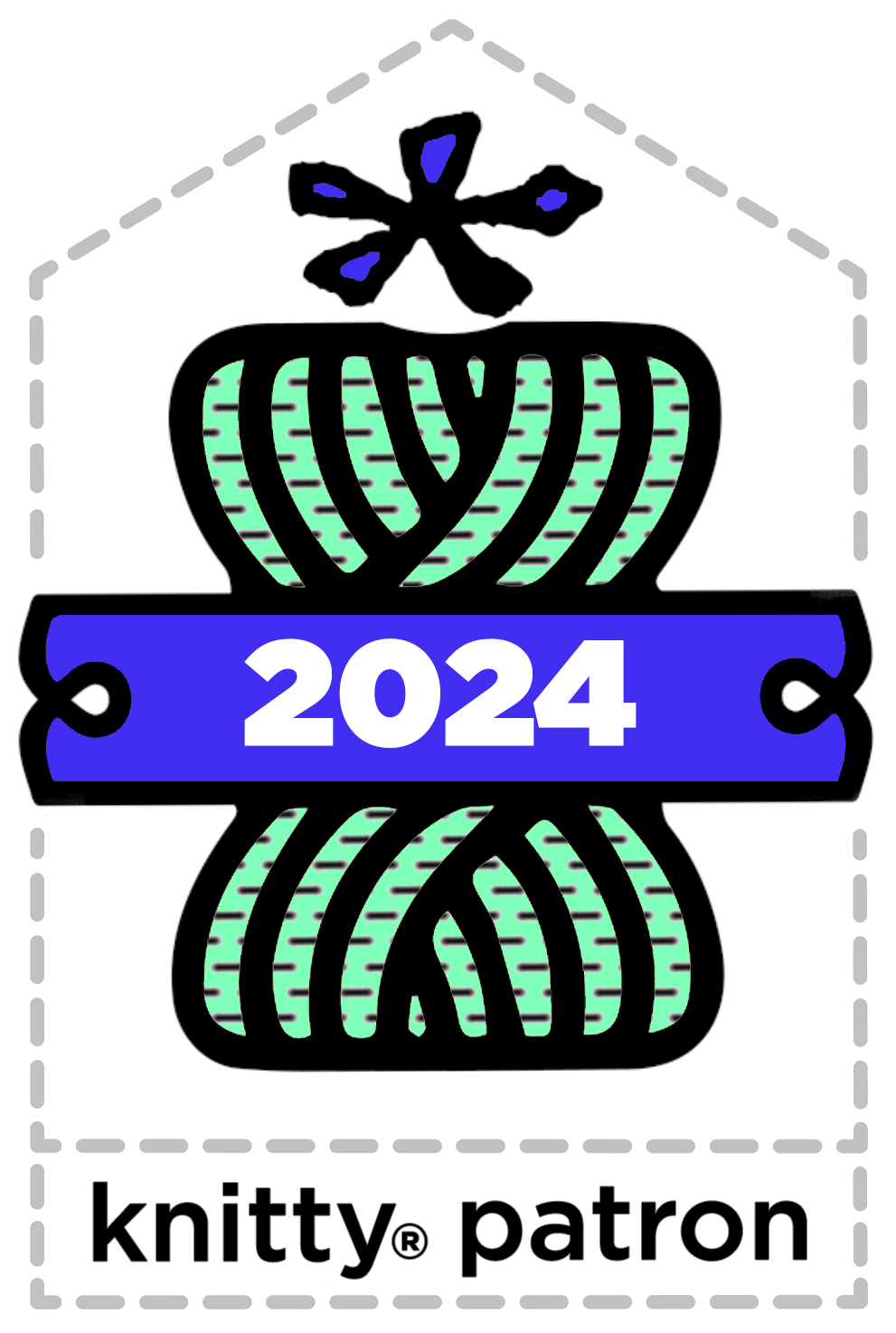Cool Stuff - Knitty's opinions on products and books we like. We don't publish reviews of things we don't like.
INTRODUCTION
Cool Stuff
SR [Finished chest measurement for sweaters] = the smallest chest measurement to the largest chest measurement we could find in the book. There may be only one pattern with the smallest or largest size, but it's in there. Books are softcover unless noted otherwise. All prices USD unless noted. We are provided with samples to review for free, and we do not publish reviews of products that do not perform well in our testing. We are not paid to review any product.
Browse the whole list of books reviewed this issue at Bookshop which gives 10% of their profits to independent bookstores across the US, and a 10% commission to Knitty for every purchase.
We also provide links to purchase on Amazon, and they give us a commission when you purchase as well. Thank you for supporting Knitty!
![]()
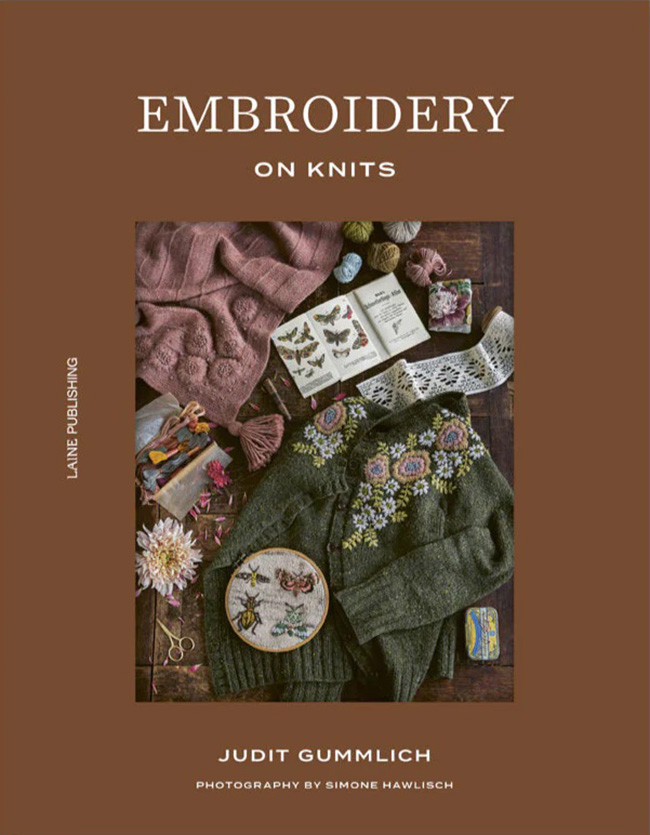
Embroidery on Knits
by Judit Gummlich
Laine Publishing
$44, hardcover
Buy now from Laine Publishing
Embroidery on Knits is book of the season, maybe the book of the year. It’s exciting and fresh; there is not a drop of preciousness to the big bold swaths of embroidery. The natural world hovers, crawls, and flourishes on sweaters and accessories. The embroidery designs can be used on handknits or commercial knits. It is written for (mostly) wool embroidery on wool.
The instruction are written so a knitter new to embroidery can follow along, but there is plenty of knowledge that experienced stitchers will benefit from.
Judit’s design style is open and free. Sometimes is it a one-color flower repeated around the bottom quarter of a sweater, sometimes the shoulder of a sweater is layered with a bird surrounded by flowers and foliage, and there are a lot of designs somewhere in between. The amount of inspiration is astonishing.
Even if you already embroider, don’t skip reading the practical how-to bits. Everything is written specifically for embroidering on knits with wool, silk, and silk ribbon. There are tips in there that only come from doing a lot of embroidery on knitwear, and Judit gets straight to the point – she wants you to get embroidering too.
There is a modest stitch dictionary, but you don’t need a vast array of stitches to do these designs, as well as excellent chapters on choosing color and stitching with silk ribbon.
All along the way there are photos, whetting your appetite, of her designs. Once the how-to is done, the projects explode in full-page photos. It kind of blows your hair back.
The projects are on mostly on sweaters, and there is a chapter on embroidering on mittens. The motifs are printed at size and can be easily traced. Each design has several photos of the whole project and a page detailing ideas for use, stitching sequence, hoop notes, and guidelines. If you look closely at the bottom of the detail page, the sweater design and yarns used are listed.
The colors and designs are organic and contemporary, they are both sublime and boisterous. This is a perfect book to have on hand through a dark winter to
follow her samples exactly or to follow her lead but go your own way, either path this book will lead you wonderful places.
JM
![]()
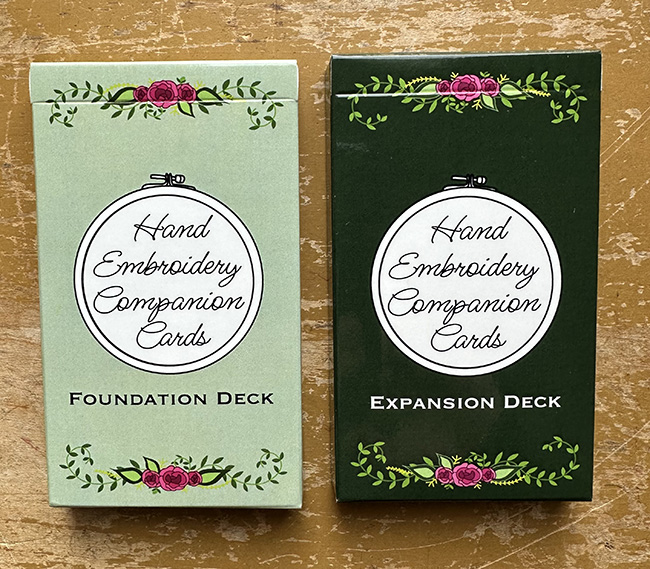
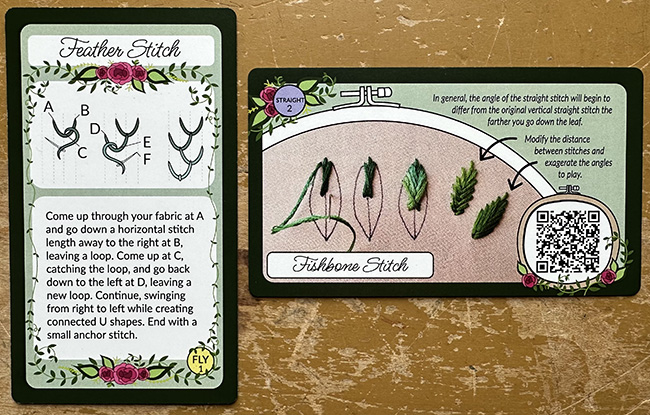
Hand Embroidery Companion Cards: Foundation Deck
Hand Embroidery Companion Cards: Expansion Deck
by Jessica Long
Jessica Long Embroidery
$35 (Foundation) $32 (Expansion)
Buy now from Jessica Long Embroidery
Looking for an easy way to add a variety of stitches to your embroidery practice? These embroidery cards are genius. They are the size of a deck of cards with 30 cards in each deck. The cards are heavy, laminated card stock, sturdier than an average Bicycle deck of cards.
Each card has a single stitch with a name, description, stitch family, stitch use, stitch tips, and a difficulty rating. There is an illustration with the steps of the stitch, a photo showing variations of the stitch, and most brilliantly a QR code for a video of the author demonstrating and talking through the stitch.
In addition to the cards each deck comes with several (Foundation Deck has 7, Expansion Deck has 4) sampler patterns of varying difficulty that use all of the stitches in the deck between them.
These cards are already an invaluable part of my stitching. They are so much easier to carry around than a stitch dictionary book. The directions, especially with the videos, are easy to follow.
These are perfect companions to the book Embroidery on Knits (see review above) to expand on Judit’s stiches.
JM
![]()
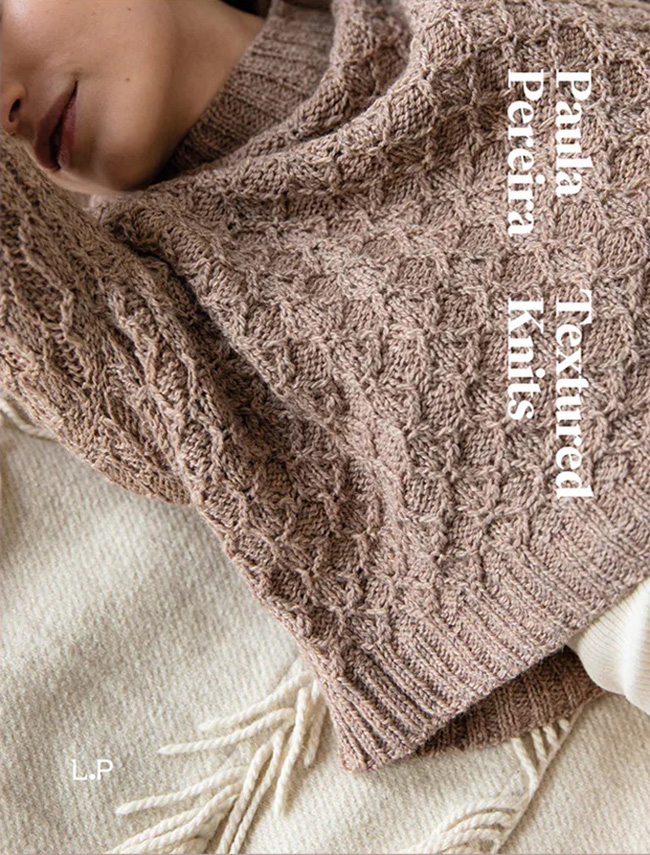
Textured Knits
by Paula Pereira
Laine Publishing
$40, hardcover
SR= 33-65"
Buy now from Laine Publishing
I’m worried that this book is going to be overlooked in this fall and winter of abundance of great knitting books. It is my favorite pattern book of this season, it’s full of fantastic and interesting patterns. Colorwork yoke sweaters have been the sweater style for a few years and I am ready for something new. The designs here are a breath of fresh air.
Paula is inspired by Brazilian art, architecture and artists and the results are sweaters (mostly sweaters, but there are a few accessories) rich in different types of texture.
Cobogó is a sweater with all-over dense texture and openwork done in two colors. Milhazes uses an airy yarn and yarnovers as a base for circular embroidery. Lina combines two colors in two different colorwork stitch patterns to make a jaw-droppingly beautiful sweater. These are just three out of the 20 patterns in the book.
Paula creates texture in her patterns in different ways, sometimes small stiches on the edges, sometimes it’s the rhythm of stripes, or different yarns used not held together but used side by side or in different parts of the design. Of course, there are traditional twists, cables, and her signature embroidery.
The designs in Textured Knits have blown the cobwebs off of my ideas for what I want to knit next. Now it’s something with texture, color, and deep Brazilian influence.
JM
![]()
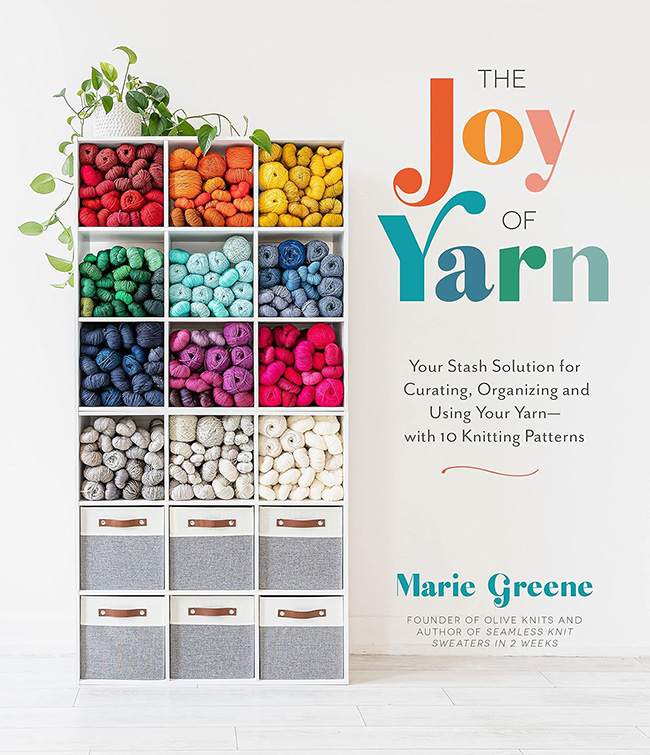
The Joy of Yarn: Your Stash Solution for Curating, Organizing, and Using Your Yarn – with 10 Knitting Patterns
by Marie Green
Page Street Publishing
$22.99
SR= 33=65"
Buy now from Bookshop.org | Amazon
Marie Greene wants to help you dig out from a stash that may have gotten out of hand. She details a friendly and very doable method of stash control in this book. The best part might be "No Yarn Diet"s. She knows, really knows, that those never work.
She instead outlines ways to uncover, organize, and inventory your yarn before she kindly walks you through what stays and what goes. It’s hard and she understands. This book comes from a place of wanting a knitter to have exactly the yarn they want to make beautiful things.
Once your yarn is pared down to perfection, she talks about how to display and further organize to keep being excited about your yarn and can find what you want. There are tips for shopping for your new stash and troubleshooting advice for pests, and changes in your creative ideas.
The book wraps up with 10 basic accessories, and a sweater pattern that help explains how to use color, and different amounts of yarn.
If you feel like your stash owns you instead of you owning your stash, this book may be a great way to start the new year.
JM
![]()
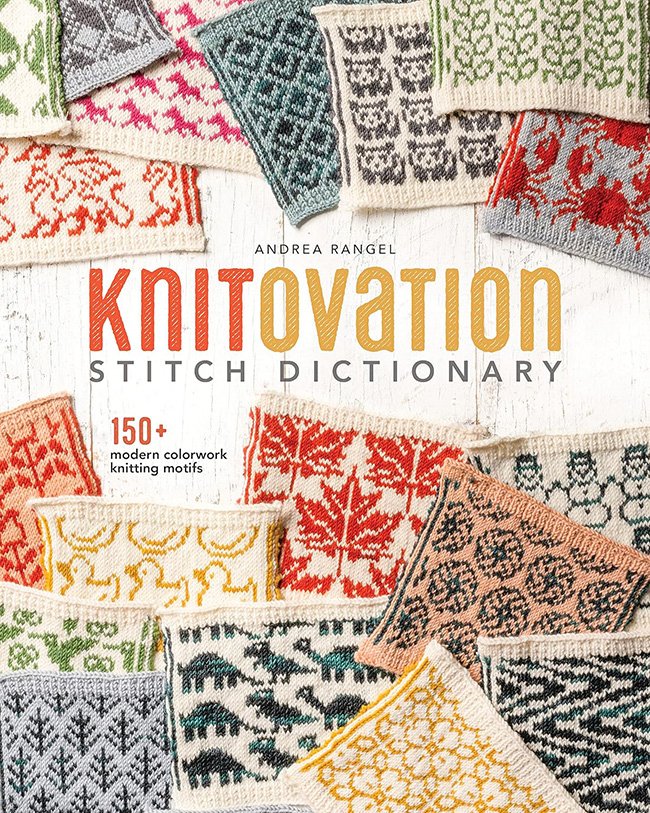
Knitovation Stitch Dictionary: 150 Modern Colorwork Knitting Motifs
by Andrea Rangel
Interweave
$28, hardcover
Sr= 33-69"
Buy now from Bookshop.org | Amazon
Knitovation is a very worthy follow up to Andrea Rangel’s outstandingly creative first book of motifs, Alterknit Stitch Dictionary. Knitovation has 150 all-new motifs, worked in partnership with her husband who designed and named the motifs. If you want to try your hand at using the motifs, there are three patterns: a hat, a sweater, and mitts to practice with.
The book has motifs that I would categorize as traditional of the hearts and flowers variety. They remind my ancient knitting self of Sasha Kagan. My favorites are when things get a little silly – Cheese vs. Mouse, Eyeball, and Corporate Fat Cat are just a few. Sometimes it’s just the name that makes me giggle, like Pondering Bear or Just a Little Airborne (a flying pig). This is a book loaded with knitting happiness.
I may like this book better than Alterknits because in Knitovation there is yarn discussion. I do love a good yarn discussion, particularly when it’s about how our choices affect knitted fabric. Andrea breaks down the basics of yarn construction and presents the perfect visuals, a motif knit using several different types of yarn.
Knitovation will help you knit yourself something truly original that will make you smile every time you wear it.
JM
![]()
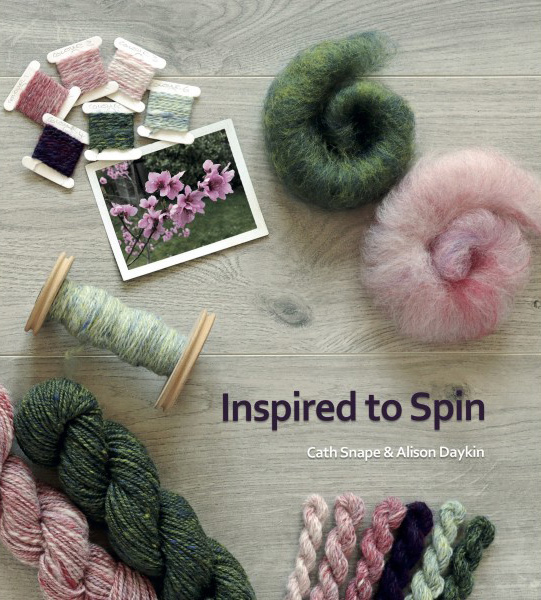
Inspired to Spin
by Cath Snape and Alison Daykin
Ashmore Publishing
£40, hardcover
Buy now from Amazon.co.uk
Inspired to Spin packs a lot of information into a single book. The authors take you from fiber to finish, with step by step instruction, clear illustrations and photos.
The book is based on the study for Cath’s Certificate of Achievement for the UK Association of Guilds of Weavers, Spinners and Dyers. If you know anything about CoAs from any country, you know that is a lot of information studied over years.
The book is divided into fourteen chapters that cover wool (including fleece selection and preparation), preparation, the construction of yarn, drafting, plying, finishing; working with cotton, silk, flax and luxury fibers; blending fiber, textured spinning and plying, and designing your own yarn. Not enough yet? There are a few projects and appendix on wheels and drive systems, and another on tips for doing a course of study.
All of this information is packed into 360 pages! It’s not a book for the newest of spinners, but if you can make a single, ply it, and have questions you will find this book useful.
Cath and Alison do a lot of things differently than I do, and I personally enjoyed refreshing my knowledge of more technical aspects of spinning, like Anne Field’s concept of spinning to the crimp.
The breadth of the book can seem daunting, but it’s not a book that need to be read and worked to from cover to cover. It’s easy to dip in and out to follow your interests and questions.
This is solid book for beginning to intermediate+ spinners.
JM
![]()
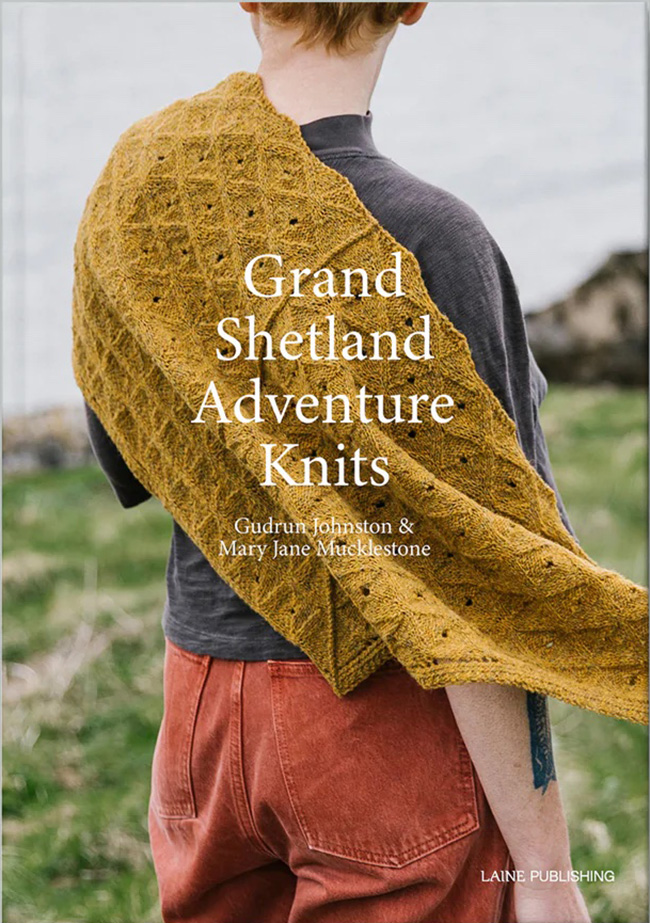
Grand Shetland Adventure
by Gudrun Johnston and Mary Jane Mucklestone
Laine Publishing
$49, hardcover
SR: 34-63"
Buy now from Laine Publishing
Grand Shetland Adventure was not what I expected, but because of that I am delighted by it. I expected a book full of traditional Fair Isle colorwork projects, but I should have known better because Gudrun Johnston and Mary Jane Mucklestone are at the helm.
The pair have been traveling to Shetland together with knitters for over a decade on their Grand Shetland Adventure, and this book captures the feeling of those trips, the impressions that Gudrun and Mary Jane have of Shetland rather than the commonplace thinking about what the Shetland Islands and their designs are.
The book has 14 knitting patterns and four travel stories. While the projects use traditional Shetland motifs and stitches the color choices and placement, and yarns veer from the traditional. The Lin V-Neck has Fair Isle patterning, just around the v-neck, really lovely. The Bousta Socks use a Spincycle color changing yarn for one of the two colors giving them a gradation of color, and the Swatchtastic Flower Hat leans on much bolder colors than you might think of for Fair Isle. There are lace projects, and Gudrun’s Lucky Lines sweater is one I could wear every day. Her garter-stitch, cardigan crossed with your favorite jammies, Riggies Cardi, is a sweater my entire family would fight over. It is perfectly cozy.
The travel stories put you right in Shetland, the punctuate the fascination and feeling of the place. You can see why knitters go back time after time, especially if they are lucky enough to go with Gudrun and Mary Jane.
JM
![]()
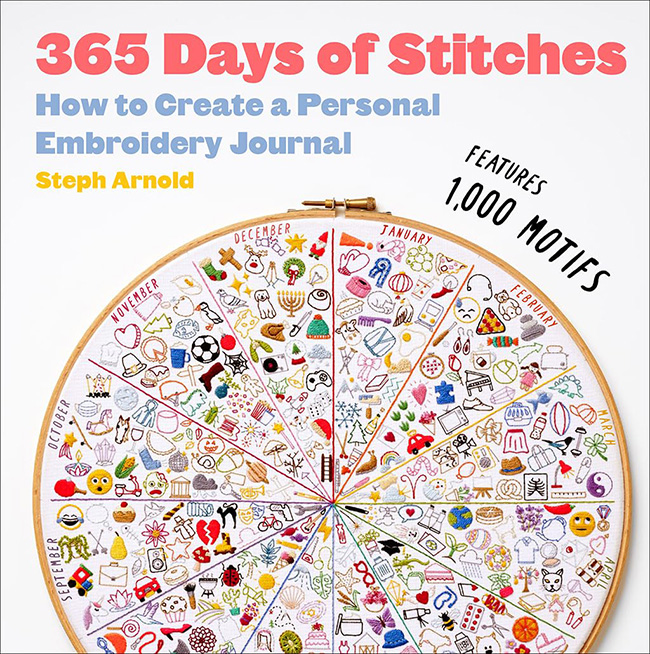
365 Days of Stitches: How to Create a Personal Embroidery Journal
by Steph Arnold
Abrams
$24.99, hardcover
Buy now from Bookshop.org | Amazon
You may have seen Steph’s stitch journal on Instagram. I know I have marveled at the tiny motifs stitched into a hoop divided into twelve sections like a giant stitchy pizza.
Her idea is to capture each day of the month, throughout the year with a single, quickly stitched motif. It’s a cool idea and once set up would be a soothing way to end each day.
Tiny stitches aren’t usually my thing, but Steph shows that it doesn’t take many stitches – they just need to be well placed and perfectly colored to achieve a recognizable motif the size of a thumbnail.
Core stitch techniques are demonstrated in illustration, with a sample motif. When Steph works tiny, I was delighted to see a single stitch could be half of a motif, for example to make a tiny campfire – use two bullion knots to make crossed logs, and a bit of red and yellow satin stitch.
There is a massive 1,000 motif dictionary divided into 50 categories like Food and Drink, Animals, Nature, and Celebration. The motifs are printed at size in black ink so they are easy to trace. DMC colors are provided for each set of motifs in case you want them exactly as shown. Steph does recommend using her ideas as springboard, using your own colors or combining motifs to really pinpoint your idea.
The book comes with an iron-on template for the pie style journal for a 12” hoop. There is discussion about alternate ways to lay out your journal in a large hoop at the beginning of the book. If you would like a preprinted stitch journal pattern you can buy that and also kits with floss from Steph’s website.
I’m not sure that I will do a stitch journal (I’m terrible at keeping up with daily practices) but I know Steph’s motifs will find their way into my other stitching and mending projects.
JM
![]()

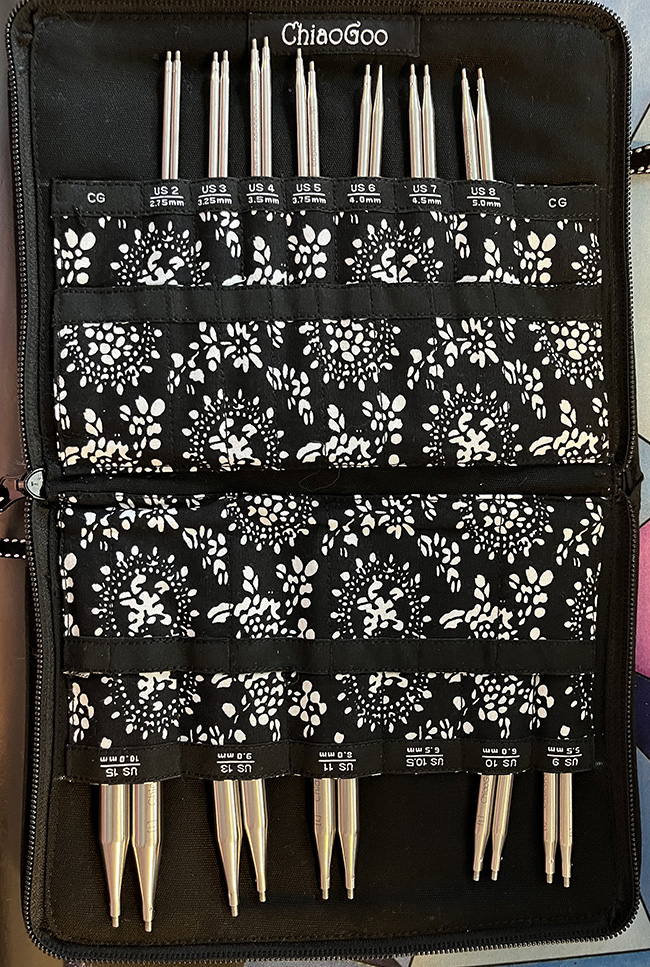
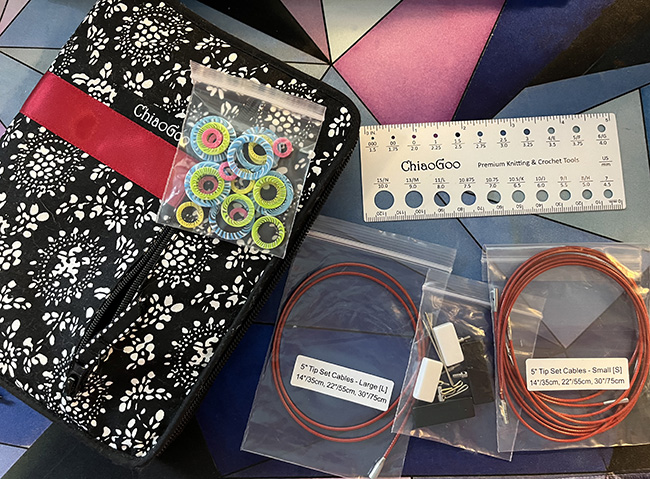
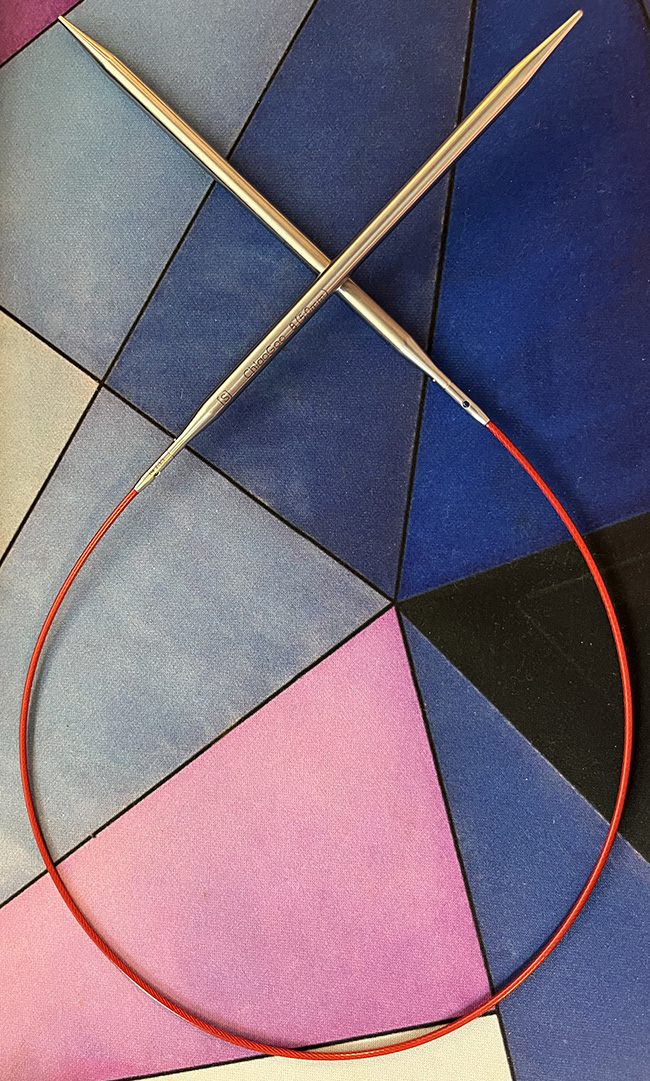
Chiaoogoo Twist Red Lace Complete Set
- 5" stainless steel tips
- sizes US 2, 3 4, 5, 6, 7, 8, 9, 10, 10.5, 11, 13, 15 | 2.76, 3.25, 3.5, 3.54, 4, 4.5, 5, 5.5, 6, 6.5, 8, 9, 10mm
- red nylon-coated memory-free steel cables in lengths of 14, 22 and 30 inches | 35, 55 and 75mm for both the small and the large needle size tips
- connectors to make super-long cables
- two end stoppers to make single-ended needles
- t-pins to tighten the connections
- cute stitch markers in a variety of sizes
- all in a case big enough for everything, with room to expand
MSRP: $214.50USD
Buy now from a yarn shop near you or (if you're stuck) Amazon
(But try your yarn shop first; if they don't have it, they can probably order it for you)
Sometimes your favorite products sneak up on you and you don't realize they're your absolute favorites until you stop reaching for anything else. That's what happened here.
I bought a few of the Chiaogoo Twist red lace (the red lace refers to the cable, not the gauge of the needle) at my LYS for a shawl I knit in the beautiful brushed alpaca silk laceweight that the indie dyers are all doing lately. I loved working it and was sad when I was done. When I had to switch to a different size needle on my next project, I missed that red cable, much more than I thought I would. So I did what a magazine editor does, and contacted the company and asked if I could buy a whole set. (Full disclosure: though most samples are provided at no cost for Knitty reviews, in this case, I paid the wholesale cost. I did not plan to review them, and I don't ask for free stuff just because I want it.)
A week after it came, my old stainless needles got sent off to another knitter. And I realized I needed to write a review, because I had never tested any Chiaogoo needles for Knitty readers before. (Why? No idea.)
I am a Chiaogoo knitter now. (I may send my very pretty wood needles off to someone else as well. Yup, I'm smitten.)
Here's why. These needles are, for me – a non-wool, occasional animal-fiber knitter in all gauges – the right solution for almost every project I knit. The cables don't kink, ever. The join between the cable and the end cap is super smooth. The join between the end cap and the needle is super smooth; you can't feel it. The tip is just the right amount of pointiness for me. The stainless steel needle is smooth but not greased-eel slippery, perfect for my mostly non-wool knitting. Stitches rarely fall off unless I'm being sloppy when I put down my needles. They almost never fall off while I'm working. I also knit alpaca, llama, yak, and synthetics, and those work perfectly on these needles too.
The three included cable lengths (to fit the small and large tips) have been sufficient for me to knit everything from hats to the full body of a sweater. When I took two cables and connected them together to make a longer needle, I could feel the join but it didn't catch anything. Stitches just slid past. I use a t-pin (included) to tighten any connection I make as I make up the needles and cable, and not once has a cable or connector come loose while working. Other stainless needles I've used have a one-material plastic/nylon cable, and I've had many of those cables completely detach from the connectors over time. Yeah, I tug on my knitting. Don't you? These, with the steel cable core, will not do that.
The only little nit-pick I had was easily fixed: I needed a pair of 7mm tips to knit a specific pattern, and that size isn't included in the set. I checked my other needle sets from different manufacturers and they didn't have a 7mm either. But Chiaogoo makes them, and so my LYS ordered them for me. Bam, solved. There are two empty slots in the case (the ones labeled CG) so there'll be room for these new tips. Oh, and the cables and needles are both marked with the size. It's not the easiest to read if your eyes are small-type challenged, but it's also not going to rub off because it's laser engraved. In any case, there's a needle sizer in the kit in case you need backup.
For me, with my little hands, I prefer the 5" tips. 4" tips of any needle are the wrong length for the way I knit (I flick, sort of American style). It's nice that you have a choice, though.
I have nothing negative to say about these needles. Nothing. They're absolutely perfect, and they're all I'm using now. The needles you see missing from the pic above are in my knitting, because they're in use. I thought you'd understand.
AS![]()
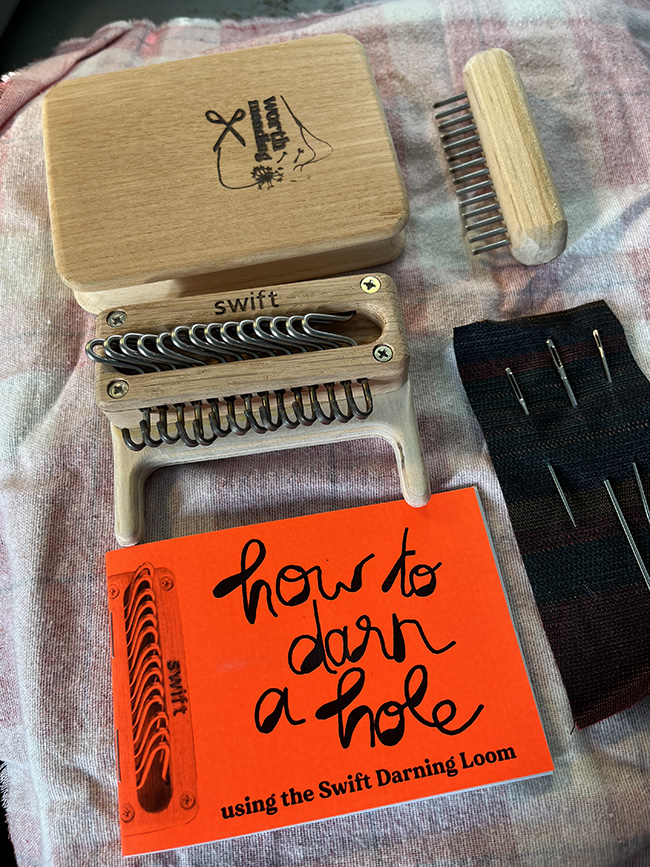
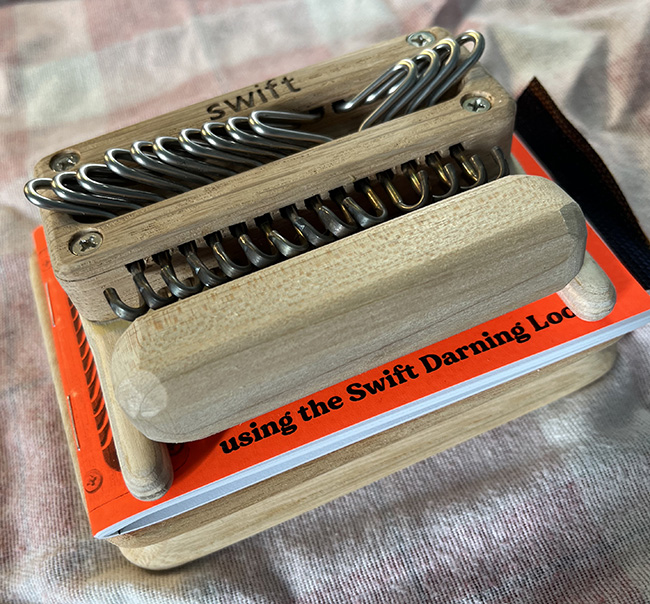
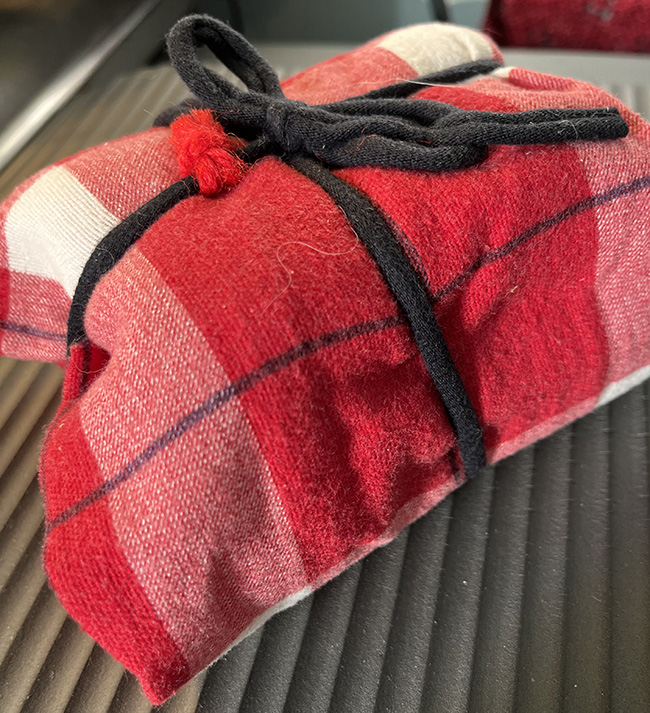
Swift Darning Loom: $120usd | $160cad
Weft pick: $25usd | $35cad
Other accessories and bundles available
Buy now from Worth Mending
This little loom and its accessories are all handmade from repurposed materials (where possible) in a little workshop in Ontario, Canada. It glows with the attention to detail that can only come from the hands of makers that care about their product. The hardwood pieces are reclaimed, and the plywood portion of the loom is high quality birch plywood. The metal hooks and teeth of the weft pick are made from reclaimed bicycle spokes (!), and it's all securely fastened together with stainless steel screws. This is a made-to-last heirloom tool.
Mine came wrapped in a piece of vintage tablecloth, and the tie is what you use to secure your to-be-mended fabric to the base of the loom (the big rectangle). It comes with a 35-page instruction book and 2 extra-long weaving needles and a sharp darning needle. This video tutorial will show you exactly how to use the loom to get great results. I confess to having bought a little cheap version of this loom months ago online, and it cannot compare to the solid build quality, smooth operation, and overall joy of using this tool to make your worn garments and accessories last longer and look beautiful after the mend.
AS
![]()

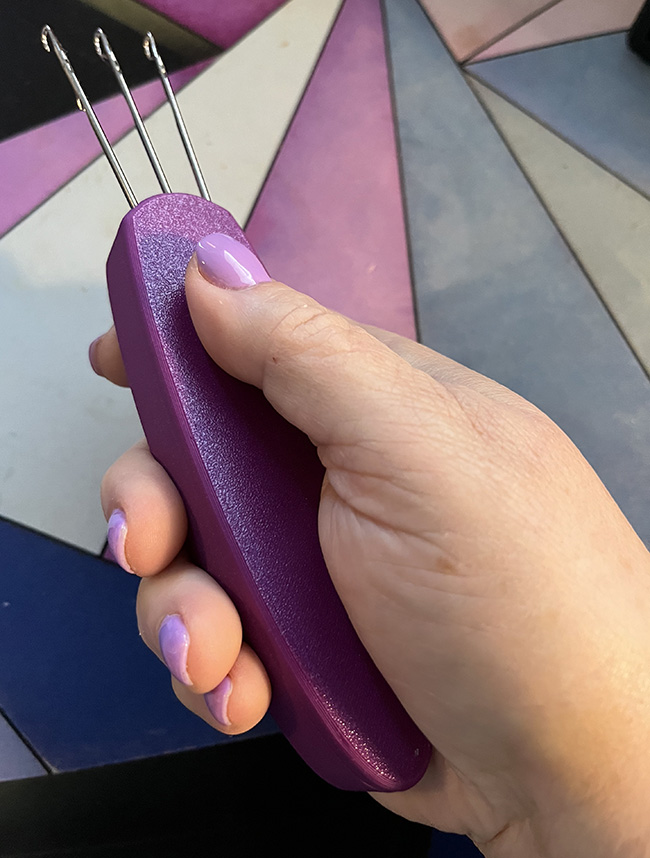
Cordsmith
by SizeInclusiveCollective
$25 for one or $40 for two
Buy now from SizeInclusiveCollective (you'll need to send a DM to place your order)
I spotted this thing whooshing by on my Instagram feed one day, but I didn't see a way to buy it. Did it even exist? Well, if it didn't then, it does now! It's the most amazing little tool, created by SizeInclusiveCollective (aka Autumn Eden Goodman) and for now, exclusively sold by DM on Instagram. She and her partner designed the Cordsmith to be 3D printed, and she assembles and sells the items one at a time from her US-based studio.
How does it work? This video shows you. You start by casting on three stitches to a regular knitting needle, then slip the stitches, one each on each of the Cordsmith hooks. Then simply wrap the yarn around the front of the hooks with the latches in the down or open position, pull the tail of the cast on stitches to bring all 3 stitches up and over the hooks. Then pull your new stitches down so the latches open and your stitches are just below the latches. Wrap the yarn in front again, above the latches, and repeat process until you have made the length of cord that you need! With a little practise, it becomes a fluid motion as you work, and you'll create the simplest, most even i-cord you've ever made.
I first tried it with fingering weight cotton and found it fiddly, so I moved to a thicker cotton (I'm wool-allergic). It took a bit to get the hang of it, following Autumn's clear video tutorial. One thing she makes a point of is that the yarn you lay over the three hooks should be done so loosely, and that makes a huge difference. Within a few minutes, I was making cord just like she did! So there's a bit of a learning curve, but it's short and pretty shallow. I would recommend avoiding using breakable yarns with this tool, because a too-firm tug on some old Summer Tweed (a raw silk/cotton blend that can break while being knit as well) ended up breaking the yarn. Not a good choice. Wools, synthetics, and normally sturdy plant fibers will work well on this tool! The tool itself is lightweight and small. As you can see above, I have a reasonably small hand, and it fits comfortably.
Cordsmith is made from PLA, which is a vegetable-based plastic. It's also heat sensitive, so don't leave your Cordsmith in a hot car! Otherwise, it's a pretty durable tool and should help you make miles and miles of i-cord with no fear of it falling off your DPN.
Cleverness abounds here.
AS
![]()
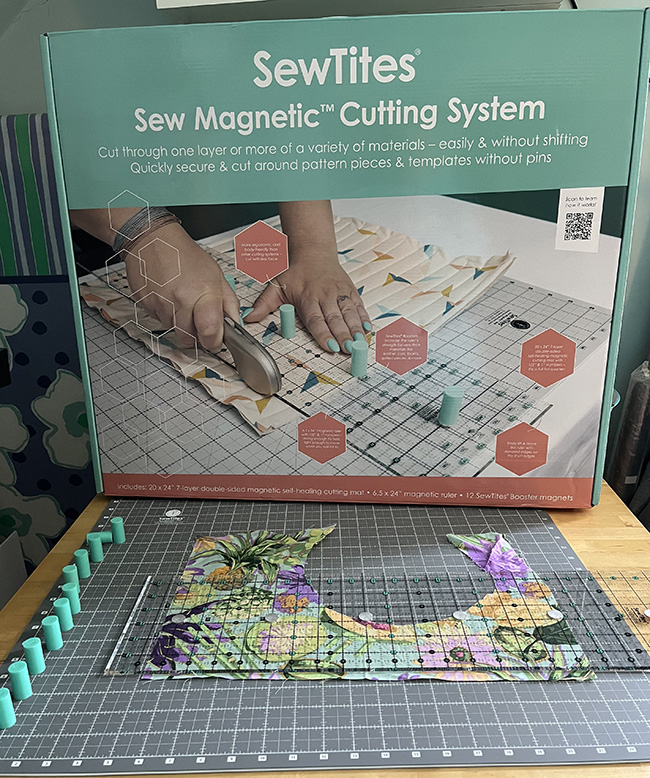
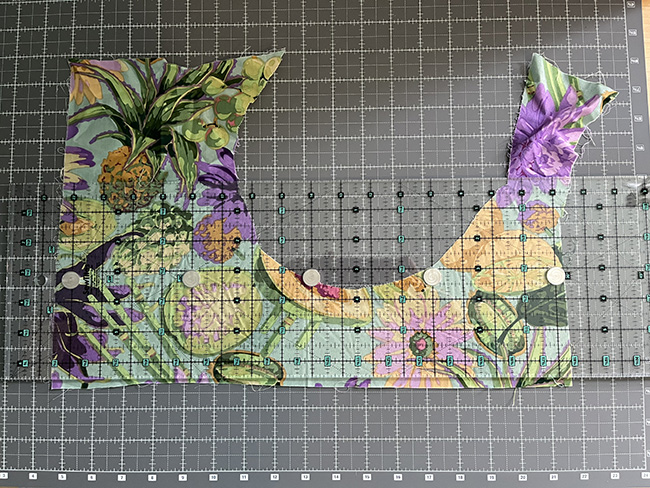
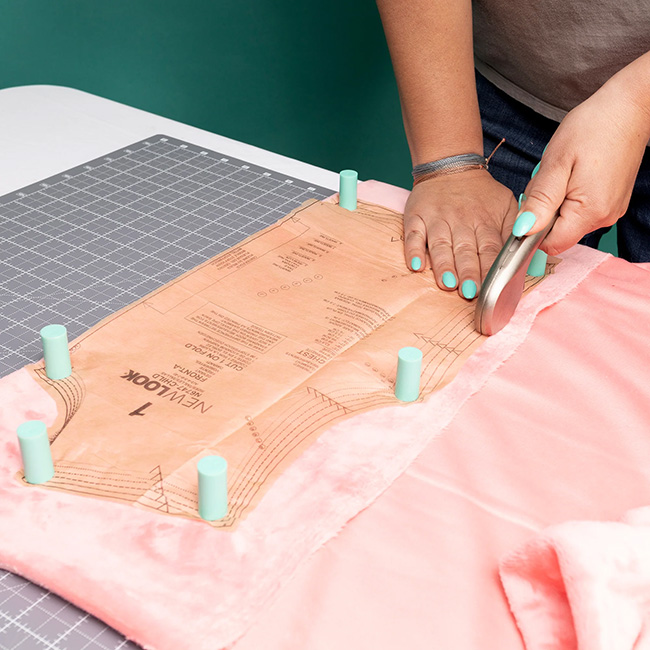

SewTites magnetic cutting system
by SewTites
available in right- and left-handed versions
Includes magnetic cutting mat, magnetic ruler and 12 SewTites Booster™ magnets in sturdy reusable storage box with carrying handle
$374.99
Buy now from sewtites.com or from your local sewing shop
I walked past the SewTites booth at the trade show this past summer, and then did a double take. What was going on here? Little pale-green towers on top of fabric? Well, they're not just towers, they're actually strong magnets made easy to grasp by their height (SewTites calls them "boosters"). And what they're attracted to is a high-quality 7-layer cutting mat with an embedded magnetic surface. So you lay your fabric on the mat, place on one or several of the boosters or the included 6.6x24" straight edge quilting ruler, or combine the two, and no matter how little strength you have in your hands, the system helps your fabric stay where you put it as you cut.
I had carpal tunnel syndrome in both hands (hand quilting gave it to me, by the way), and in 2016, I had two surgeries to fix them. They no longer hurt, but my hand strength has never fully recovered, and after cutting a little corner off the tip of my left pointer finger years ago while cutting blocks, I have been scared to hold a rotary cutter. I was sent a sample of this system to try, and decided now was the time to get over my fears. With the help of the tall booster magnets, which were super easy to place and reposition as needed, I had no trouble at all securing my fabric and pattern exactly flat on the mat. I normally would use scissors to cut out a pattern piece from fabric, but with the magnets holding the pattern in place, I went for it. Nothing moved. I would never have tried this with my old trusty soup can weighs, and what I got this time was a much more accurately cut pattern piece than if I'd even used scissors, because the base fabric stayed flat the whole time I was cutting.
The quilting ruler has all the standard measurement lines you'll need if you quilt, as well as embedded magnets. And you can take the boosters and add them to the existing magnets to make the hold even stronger. Sure, you can move the ruler if you want to. You can't rely solely on the magnets to hold your ruler steady. But applying basic pressure on the ruler to hold it flat, the magnets are like little extra hands that help you keep it where you put it while you're cutting. It really makes a noticeable difference compared to traditional unmagnetized rulers and cutting mats. This is something I've always had trouble with – my quilting rulers sliding all over the place especially during the last 1/3 of a cut – and now that I have the SewTites tools, I am looking forward to getting back to quilting!
The cutting mat is not just magnetic and well made, but it's also reversible. One side is dark grey with white lines and the other is light grey with black lines – makes it easy to choose a side that contrasts with the fabric you're cutting so you can see what you're doing more easily.
Yes, this isn't a budget purchase. But for people with reduced mobility or reduced strength in their hands, it is an invaluable aid. For everyone who can be sometimes distracted while using sharp implements (like me), having the extra help of the magnets means everything is much less likely to slip and that makes cutting much safer and more relaxing.
AS
![]()







